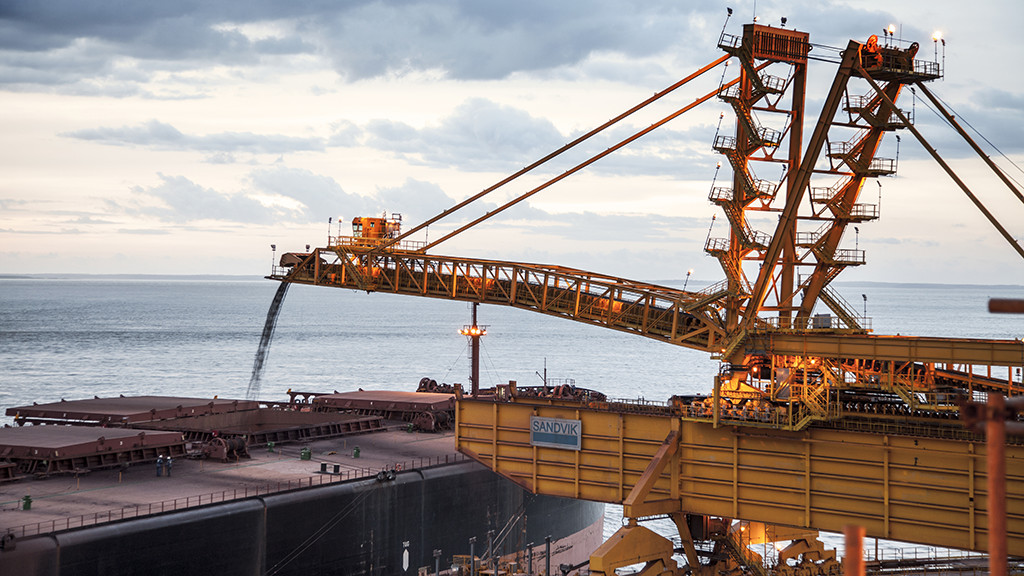One secure, sustainable giant
Environment, health and safety considerations are the first steps towards increased productivity for Vale, the world’s biggest iron ore producer. This is also the case for the company’s Pier IV project at the São Luís port in Brazil.
At the São Luís port, red-coloured iron ore is loaded onto huge cargo ships by the world’s largest shiploaders, Sandvik DLP400. The use of large, advanced equipment calls for special measures when it comes to health and safety, which Vale considers key to increased productivity.
“Vale pursues excellence in health and safety,” says Magno Silva, health and safety implementation leader at Vale.
The safety functions on the shiploaders are significant for safe running of the machines.
“The machine equipment has an advanced, up-to-date automation system,” Silva says. “There are displays in the shiploader’s operation cabin that identify any issue in the process and point out the problem’s exact location.”
Attention to safety helps the company’s productivity as it reduces the chance of losses from accidents, he explains. “Vale’s main value is life, and we always prioritize this principle,” he says. “When there is no loss, productivity remains intact.”
Regulations followed to the letter
Not only are there colossal shiploaders at Pier IV, but Sandvik PC conveyor belts close to three kilometres long are running at full speed. The conveyor system looks a bit like a roller coaster, but the speed is far faster than amusement park rides. High speeds pose risks, so strict safety measures are always in place around the conveyor system. Security railings are put up all around the equipment. Still, maintenance is easy, thanks to unlimited access engineered into the design.
The port is a hive of activity, with machinery, cars and people moving around. Security protocols are always in place, and safety gear is worn at all times. It’s crucial to follow safety regulations to the letter.
“Some safety equipment is common in all areas, such as helmets, goggles and safety shoes with steel toes,” Silva says. “Other safety gear is determined according to the risks in each area.”
Hearing protection is worn in most areas. In some places the surroundings seem calmer, but there is always something moving about, so alertness is a must.
Mechanisms for increased safety
The giant shiploader wheels are running back and forth on the tracks. They move slowly but are enormous, like pyramids of wheels. As an extra precaution, a signal alerts all personnel every time the wheels move.
When the Sandvik PL400 shiploaders were erected on Pier IV in São Luís, Sandvik participated in the process, giving Vale peace of mind. “The participation by the Sandvik representatives was crucial because they monitored everything from the beginning of the manufacturing, which means we avoided the need to correct or add to the safety system after the equipment was assembled,” Silva says.
The advanced automation system makes the work for the machine operators much easier.
José Oliveira, Sandvik PL400 operator at Vale, says the shiploader’s safety mechanisms make the operations smoother.
“There are safety devices in all of the shiploader’s movements,” he says. “There are different limits: normal halt and emergency halt. But these limits are only preventive; they don’t interfere in the daily operation.”
“I feel safe”
The Sandvik PL400 operators work from the operator cabin located about 25 metres up on the end boom, the shiploader’s “bridge”. Reaching the cabin requires a long climb through a labyrinth of stairs. Oliveira thinks the shiploader’s operating cabin is a positive workplace.
“I feel safe up there, and I’m used to operating the equipment,” he says. “The cabins are practically rooms. They’re comfortable, and we have the control system on the computer display as a guide at all times about the loaded amount. We also have the supervision team to support us via radio communication.”
Inside the cabin the air conditioning and soundproofed walls are a welcome break from the tropical heat and noise outside. On the conveyor belts underneath the cabin, the iron ore comes flowing like a river and then streams like a waterfall down into the vast loading compartments on the cargo vessel.
The iron ore that is loaded onto the giant Valemax ships, the biggest cargo ships in the world, comes from the Carájas mine, the world’s largest open pit iron ore mine, 226 kilometres away.
Environmental measures
Environmental sustainability is also an important factor for increasing productivity. At Carajás, for example, Vale has launched the S11D project with the aim of mining iron ore in a less expensive and more environmentally friendly way. Measures have been taken to minimize the consumption of water, fuel and electricity.
At the port, the concealed system on the Sandvik shiploaders is another important part of the sustainability measurements, Silva says.
“The shiploaders have a totally concealed system, and that prevents the emission of particles to the environment,” he says. “Also, Sandvik conveyor belts have cleaning belts that prevent any spill of material.”

/https%3A%2F%2Fsolidground.sandvik%2Fwp-content%2Fuploads%2F2015%2F08%2FVale_EHS_Minestories5.jpg)
/https%3A%2F%2Fsolidground.sandvik%2Fwp-content%2Fuploads%2F2015%2F08%2FVale_EHS_Minestories4.jpg)
/https%3A%2F%2Fsolidground.sandvik%2Fwp-content%2Fuploads%2F2015%2F08%2FVale_EHS_Minestories3.jpg)
/https%3A%2F%2Fsolidground.sandvik%2Fwp-content%2Fuploads%2F2015%2F08%2FVale_EHS_Minestories2.jpg)

/https%3A%2F%2Fsolidground.sandvik%2Fwp-content%2Fuploads%2F2023%2F05%2Fth665b_001.jpg)
/https%3A%2F%2Fsolidground.sandvik%2Fwp-content%2Fuploads%2F2023%2F05%2FLH518iB_03437.jpg)
/https%3A%2F%2Fsolidground.sandvik%2Fwp-content%2Fuploads%2F2023%2F05%2Fmodule-high-res_Frilagd.png)
/https%3A%2F%2Fsolidground.sandvik%2Fwp-content%2Fuploads%2F2023%2F05%2FADLA230201_060.jpg)
/https%3A%2F%2Fsolidground.sandvik%2Fwp-content%2Fuploads%2F2022%2F12%2FADLA211207_070_2500px.jpg)
/https%3A%2F%2Fsolidground.sandvik%2Fwp-content%2Fuploads%2F2022%2F08%2FADLA211214_059.jpg)
/https%3A%2F%2Fsolidground.sandvik%2Fwp-content%2Fuploads%2F2021%2F04%2FKiruna_132_1600x750-1.jpg)
/https%3A%2F%2Fsolidground.sandvik%2Fwp-content%2Fuploads%2F2021%2F04%2FLH518B-Front-Left2_1600x750.jpg)
/https%3A%2F%2Fsolidground.sandvik%2Fwp-content%2Fuploads%2F2021%2F09%2FTH550B-24m-heading-swap0000_1600x570.jpg)
/https%3A%2F%2Fsolidground.sandvik%2Fwp-content%2Fuploads%2F2020%2F08%2FLH514BE_1600x570.jpg)
/https%3A%2F%2Fsolidground.sandvik%2Fwp-content%2Fuploads%2F2020%2F08%2FSustainability-Electric_1600x570.jpg)
/https%3A%2F%2Fsolidground.sandvik%2Fwp-content%2Fuploads%2F2020%2F05%2FA10-underground_1600x570.jpg)